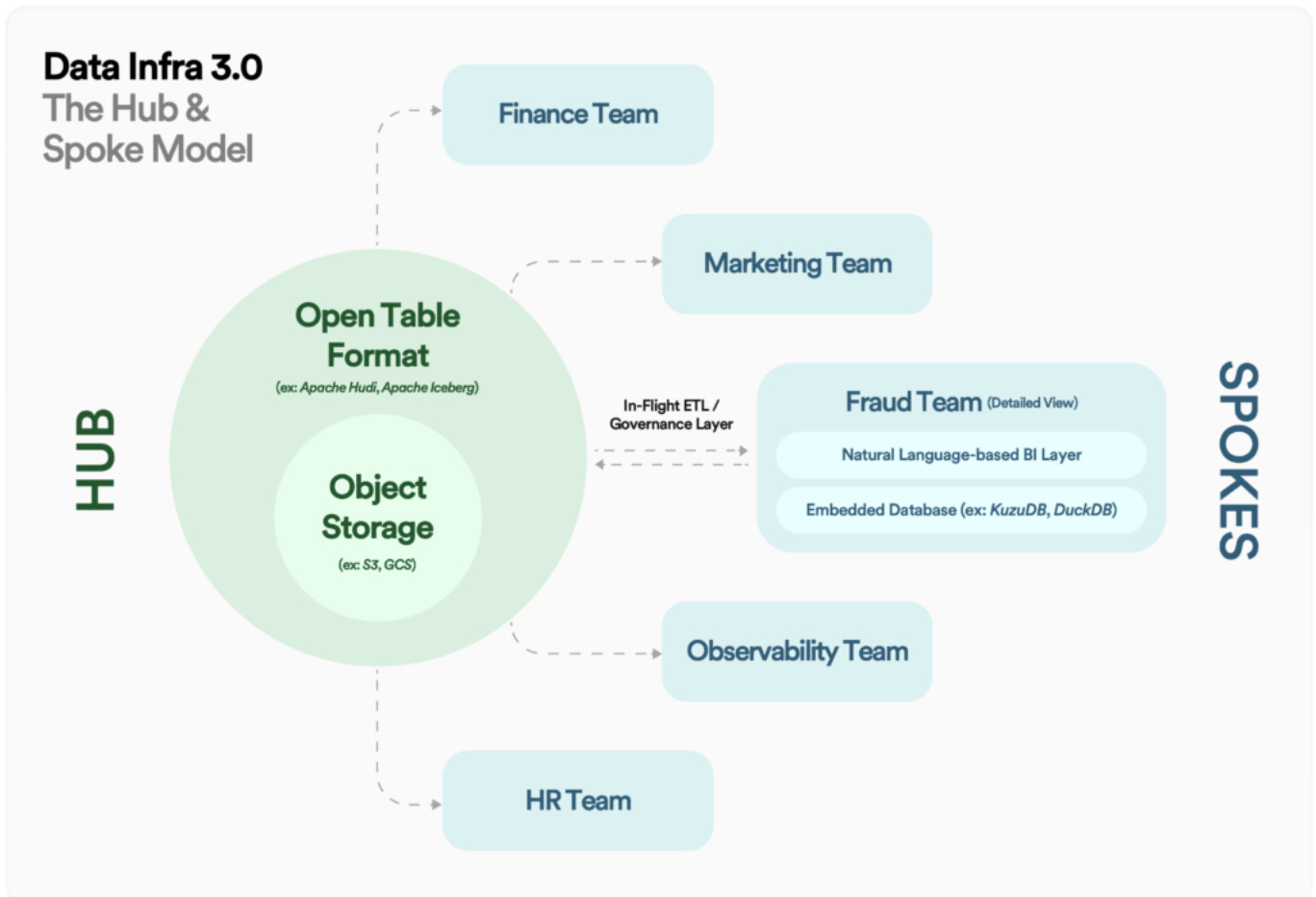Incumbents vs. Startups: The Showdown Over Generative AI
I explore the debate over who benefits most from generative AI—incumbents or startups—and share where I think startups have an edge. I then dive deeper with a leading AI founder, Robert Nishihara.
11.17.2023 | By: Ashu Garg

In recent weeks, a classic debate in tech circles—incumbents versus startups—has resurfaced, with generative AI as the battleground. On one side stands big tech, armed with deep pockets, established distribution channels, brand recognition, and troves of data. On the other side are startups, agile, ambitious, and unconstrained by legacy systems, ready to disrupt.
In this month’s newsletter, I make the case for both camps. I then offer my own perspective, along with the key opportunities that I see for startups in the generative AI wave.
Camp #1: Incumbents will gain ground
The first camp views generative AI as an iPhone moment: a transformative technology to be sure, but one that further entrenches big tech. In the mid-2000s, incumbents like Apple, Google, and Salesforce outmaneuvered a crop of VC-backed “mobile-first” startups by simply adapting their products for mobile platforms. By analogy, this groups views generative AI as an extending innovation that advantages present-day winners: something that they can just “add on,” much like they “added on” mobile apps. Consider Microsoft Copilot: an AI assistant that Microsoft is incorporating across its suite, from 365 to Windows 11, Edge, and Bing. According to analysts, Copilot could generate $14 billion in annual revenue, assuming just a 10% uptake by current corporate customers.
Investor Sam Lessin echoes this sentiment, dismissing generative AI as a “narrative” born of “desperation in the VC community versus good sense.” In his view, mega caps will cement their dominance by enhancing their products with generative AI, while small “mom and pops” will also benefit by using generative AI to boost productivity in areas like marketing, sales, and product development. As for VC-backed startups? With no IP moats and data advantages eroded by each successive foundation model release, they’re “F*ed.”
Camp #2: Startups will thrive
The second camp argues that generative AI marks the start of a profound innovation cycle for startups, much like the early internet era that birthed Google, Amazon, and Facebook. These companies, initially startups themselves, captured most of the value in the first AI wave. Yet today’s transformer-based models represent a monumental leap forward from CNNs, RNNs, and GANs. Generative AI promises the proverbial “10x better” needed for startups to take on incumbents.

Looking to Microsoft again proves instructive. In his annual letter, Satya Nadella identifies two breakthroughs that set generative AI apart from previous forms of AI. The first is the rise of natural language as a universal interface. As my partner, Steve Vassallo, has explored at length, the blank text box is just the beginning. Interfaces designed from the ground up around generative AI will unlock new modes of interaction and user experiences that startups are uniquely positioned to exploit.
The second is the emergence of LLMs as powerful reasoning engines. Equipped with the ability to exercise judgment and use external tools, generative AI applications are evolving from basic autocomplete to complex systems capable of autonomously solving problems from start to finish. Incumbents may struggle to integrate these capabilities without taking on unacceptable risks (given the size of their user bases) or cannibalizing profitable business models. Here, again, startups have the upper hand.
As members of this camp like to emphasize, we’re still very much in the first inning of generative AI. The breakneck pace of AI development makes it impossible to foresee what best-in-class entrepreneurs will invent. To counter naysayers, they spotlight a different example from the mobile revolution. While incumbents simply adapted existing offerings into mobile apps, startups like Uber, Airbnb, and TIkTok capitalized on the unique possibilities of mobile, including touchscreens, GPS, cameras, sensors, and digital payments, to create truly “mobile-native” products.
In the case of generative AI, multi-modal understanding, reasoning, content creation, knowledge representation, hyper-personalization, and agentic systems create a rich design canvas for startups. Entrepreneurs who recognize these opportunities early and build innovative products designed from first principles around generative AI will see great success.
How I See It: Five Opportunities for Startups
As a long-time champion of startups, I’m naturally inclined toward camp #2. It’s my view that generative AI marks an internet moment for startups, albeit with some key differences. I concede to camp #1 that, unlike the early internet, today’s AI field features formidable incumbents whose existence constrains the surface area that startups can capture. At the same time, by putting their weight behind AI—most notably, Meta, with its support of the open-source model ecosystem through LLaMa—they’re providing founders with invaluable building blocks.
When AI is simply an add-on feature, incumbents will win. However, when AI enables fundamental transformations in workflows and human behavior, startups will find openings. For these founders, the key will be developing products that are “gen-AI native,” rather than incremental improvements that incumbents can copy-paste. As always, successful founders will begin from real user needs and target underserved markets. Moats may lie in proprietary training data (especially in specialized domains like biotech, finance, healthcare, and law), customized workflows, deep integrations, and network effects fueled by community engagement and size.
To get more granular, here are five opportunities that I see for generative AI founders:
- Vertical AI
When combined with generative AI, vertical SaaS assume next-level powers to optimize custom workflows, automate specialized tasks, and personalize experiences to each organization’s and user’s needs. Our portfolio company, ConverzAI, which is building a voice-powered, generative AI agent for recruiting, is a prime example. Other vertical AI startups in sectors like architecture, education, finance, healthcare, and law that have large TAMs and low rates of generative AI adoption show promise. - Horizontal AI
Startups in this space that are automating business processes that cut across industries will face stiff competition from incumbents. But they have a distinct advantage, given how radically legacy workflows—which typically involve a patchwork of different software tools, data systems, and human inputs—will need to be overhauled in order to effectively incorporate AI. If startups can redesign these processes with generative AI at their core, they can drive dramatic efficiency gains. Startups in our portfolio like Eightfold (HR) and Regie.ai (demand generation) are strong examples. - “Copilots” for specific personas
Evidently.io is doing this for doctors: creating a cognitive AI assistant specifically tailored to how MDs work. There’s ample space to build copilots for other knowledge-intensive professions, such as engineering, design, and data analysis. - Selling AI-generated work
Rather than sell software that marginally increases productivity (as has been the norm for the past two-plus decades of SaaS), startups can use AI to sell the end product of work. This approach allows startups to compete directly with the cost of human labor. It also opens up new verticals that traditional software models can’t serve, such as accounting, auditing, back-office tasks, legal output, and patent writing. - Infrastructure
Unlike the first wave of CNN/RNN/GAN-based AI startups, the generative AI wave has seen a cohort of AI infrastructure providers gain tremendous traction. Foundation model providers and marketplaces like Anthropic, Hugging Face, and OpenAI, along with our portfolio companies Arize, Fortanix, Skyflow, and Watchful, are filling major gaps left by incumbent platforms and dev tools. Collectively, they comprise a “modern AI stack”: a suite of tools around data pipelines, model deployment and inference, observability and monitoring, and security needed to put generative AI models into production. This stack is highly fluid, as the ideal architecture for building generative AI apps (RLHF, RAG, fine-tuning, prompt engineering, or some combination of the four?) is yet to be determined and will change as the underlying models improve.
Some predict that OpenAI will monopolize the ecosystem: hence, the buzz around a “startup mass extinction event” after their inaugural DevDay last week. Yet, while it’s still best for startups to avoid anything on their roadmap, OpenAI’s future may not be straightforwardly up and to the right. Their ambition to target both consumer and enterprise markets could dilute their focus, while the recent ouster of CEO Sam Altman hints at potentially serious internal turmoil. All of this clears space for new entrants to zero in on specific use cases and customer profiles.
With this in mind, I see two specific openings for infrastructure startups:
- The first is creating end-to-end solutions that allow companies to adopt open-source models and avoid vendor lock-in. Recent research suggests that a multi-model approach is becoming table stakes, with 60% of enterprises making use of routing architectures that assign tasks to the most suitable model. Our portfolio company Anyscale, built atop the open-source distributed computing framework, Ray, is building just such a solution for enterprise AI. (Check out my podcast with its co-founder and CEO, Robert Nishihara: more details below!)
- The second exists around new proprietary model architectures. Ikigai, another of our portfolio companies, is developing a suite of large graphical models optimized for structured data: a crucial enterprise asset, yet an area where current generative models are not as performant.
Parting Thoughts
While it’s true that the path ahead poses challenges for startups, it always has. To secure a place in the enterprise market, startups must deliver solutions that far surpass existing alternatives. Their success depends on exceptional teams, bold visions, and relentless execution.
Yet the immense value that generative AI will create means that players at all scales and stages of growth can win. To again paraphrase Satya’s annual letter, generative AI will transform every layer of our current technology stack. As AI powers an ever-increasing share of the global economy, the TAM for software will expand by an order of magnitude. Even sectors that have long been the strongholds of incumbents, such as search, could face disruption as generative AI matures.
Until now, human intelligence and agency have been the main driving forces in our world. With generative AI, we’re creating new, nonhuman forms of reasoning that may far surpass our own. It’s wise to remember Amara’s Law: we tend to overestimate the effects of new technologies in the short run and underestimate them in the long run. With this as context, one thing is clear: for all the talk of hype and bubbles, generative AI represents a generational moment for tech startups and incumbents alike.
How to Power the AI Boom
This month on the B2BaCEO podcast, I speak with Robert Nishihara, co-founder and CEO of Anyscale. Anyscale’s aspiration is to build the fastest, most cost-efficient infrastructure for running LLMs and AI workloads. When it is successful, Anyscale will be to the AI era what Microsoft was for the PC era: the underlying operating system on which all AI applications are developed and run.

Anyscale is built on Ray, an open-source compute framework that Robert and his co-founders developed as PhD students at UC Berkeley. Under the guidance of Professor Ion Stoica, who also co-founded Conviva and Databricks, the team sought to make distributed computing broadly accessible. Anyscale was then launched as a fully managed platform for Ray, making even the toughest problems in distributed computing easy for developers to tackle.
Today, Anyscale is a billion-dollar business powering mission-critical AI use cases at companies like Amazon, Cohere, Hugging Face, NVIDIA, OpenAI, and Visa.
If you’ve been a PhD student at UC Berkeley, created a popular open-source framework, and built a billion-dollar business on top of it, you’ve likely learned a thing or two along the way. Robert’s story offers valuable lessons for fellow founders and builders at all stages of the startup journey.
Why Generative AI Needs Design
In his latest article for Forbes, my partner Steve Vassallo explores the intersection of design and AI. A long-time advocate for the importance of human-centered design, Steve explains how thoughtful, deliberate design can help us harness AI’s immense potential while ensuring that it acts in harmony with our values and goals.

Here are a few things he’s thinking about:
- Lowering the Floor, Raising the Ceiling
Imagine the space of design as having a floor (minimum skill) and ceiling (maximum potential). AI lowers the floor: prompts easily turn ideas into prototypes. AI also raises the ceiling, pushing out the frontier of what experts can achieve. - From Pixels to Patterns
While designers often focus on isolated elements, true design thinks in patterns, attending to the user’s entire journey and the links between steps. AI accelerates this shift, allowing designers to article their vision while it handles the details. - Beyond the Text Box
Chat interfaces are a helpful onramp, yet they’re not as simple or obvious as they appear. Absent cues, users struggle to articulate intent, needs and goals. More fluent abstractions for AI capabilities can unlock richer forms of human-AI collaboration. - Solving AI’s “Last Mile” Problem
Generative AI models are far from foolproof. Strategic design solutions, such as confirmation prompts, uncertainty estimates & explainability features, can bridge the gap between “gee whiz!” demos and real-world reliability.
Data Infrastructure “3.0”
In his recent post, my partner Vinay Iyengar outlines his vision for the future of enterprise data infrastructure, which he calls the “data hub and spoke.” Driven by increasing pressures on enterprise budgets, the growing complexity of data, and the transformative impact of generative AI, this hybrid approach combines centralized visibility with decentralized access.
At its core is a unified “hub” built using a cost-effective lakehouse design. Branching out from this hub are “spokes”: domain-specific teams within the enterprise, such as finance, fraud, HR, marketing, and observability. These teams both connect to and exchange data with the hub. Empowered by natural-language interfaces, each independently owns and manages its own analytics efforts without relying on data science or engineering.
Long term, Vinay envisions these spokes evolving into AI-enabled agents that can pull in real-time data and answer queries autonomously, with built-in safeguards for security and governance.

To dive deeper and explore the top opportunities that Vinay sees for startups—including rebundling, vertical-specific data stacks, open-core business models, and new analytics interfaces—I highly recommend reading the full post!
Why AI Won’t Destroy the World
This fall, my partner Joanne Chen spoke at TEDx about the immense promise that all of us at Foundation Capital see in AI. She shared her conviction about why this technology, if developed thoughtfully, will make our world more prosperous, equitable, and fundamentally human.
As Joanne explains, we humans have always created tools to extend our abilities, from the wheel to the TV to the computer. AI is the next chapter in this timeless story. By partnering with its unique intelligence, we can achieve far more than on our own.
Here are the high-level bullets:
- More prosperous
Joanne sees AI as a massive increase in the global supply of intelligence. Per Jevons’ paradox shows, a greater supply of intelligence will spur an ever-increasing demand for intelligence. We’ll use AI to do more things, better and more efficiently. This prosperity will create more jobs. - More equitable
AI can customize and democratize access to healthcare, tutor our children, and remove language barriers through real-time translation. In doing so, it promises a future where ideas and opportunities are accessible to all, not just a fortunate few. - More human
AI excels at predictions but lacks emotional depth. Our empathy, compassion, andself-awareness will remain traits that are uniquely ours. As AI expands its reach, these traits will become more valuable than ever.
After watching (and rewatching!) her talk, Joanne left me filled with optimism about AI’s ability to make the world immeasurably better. It’s is a must-see antidote to doomsday defeatism.
Published on 11.17.2023
Written by Ashu Garg


